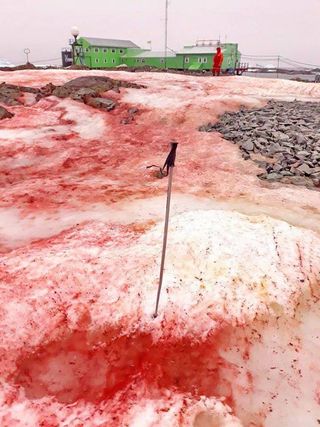Spooky 'blood snow' invades Antarctic island
The blood-red algae behind the phenomenon could kick off a runaway feedback loop of warming, researchers warned.

It's summer in Antarctica, which means record-high temperatures, jarring glacial melt and — in a very metal symbol of our changing climate — a bit of blood-red snow spattered across the Antarctic Peninsula.
Over the past several weeks, the ice around Ukraine's Vernadsky Research Base (located on Galindez Island, off the coast of Antarctica's northernmost peninsula) has been coated in what researchers are calling "raspberry snow." A Facebook post by the Ministry of Education and Science of Ukraine shows the scene in full detail: streaks of red and pink slashing across the edges of glaciers and puddling on the frosty plains.

That blood (or "jam" as the researchers whimsically call it) is actually a type of red-pigmented alga called Chlamydomonas Chlamydomonas nivalis, which hides in snowfields and mountains worldwide. The algae thrive in freezing water and spend winters lying dormant in snow and ice; when summer comes and the snow melts, the algae bloom, spreading red, flower-like spores.
Related: Gobs of sea-foam wash up in Spanish town. Here’s why.
This phenomenon, which Aristotle noticed way back in the third century B.C., is known as "watermelon snow," "blood snow" and a host of other less poetic names.
The phenomenon's red color comes from carotenoids (the same pigments that make pumpkins and carrots orange) in the algae's chloroplasts. In addition to their crimson hue, these pigments also absorb heat and protect the algae from ultraviolet light, allowing the organisms to bask in the summer sun's nutrients without risk of genetic mutations.
That's good for the algae but not great for the ice. According to the Ukrainian researchers, it’s easy for these blooms to kick off a runaway feedback loop of warming and melting.
Sign up for the Live Science daily newsletter now
Get the world’s most fascinating discoveries delivered straight to your inbox.
"Snow blossoms contribute to climate change," the team wrote in the Facebook post. "Because of the red-crimson color, the snow reflects less sunlight and melts faster. As a consequence, it produces more and more bright algae."
The more heat the algae absorbs, the faster the surrounding ice melts. The more ice that melts, the faster the algae can spread. That, in turn, leads to more warming, more melting, and more algal blooming.
A similar feedback process is driving more extreme algal blooms in oceans all over the world, resulting in surreal scenes like an invasion of sea foam in Spain and blue, bioluminescent "tears" clinging to China's coasts. While watermelon snow has existed for millions of years, algal blooms thrive in warm weather, meaning we can probably expect to see more events like this as the climate changes.
- Images of melt: Earth's vanishing ice
- The reality of climate change: 10 myths busted
- Top 10 ways to destroy Earth
Originally published on Live Science.
OFFER: Save at least 53% with our latest magazine deal!
With impressive cutaway illustrations that show how things function, and mindblowing photography of the world’s most inspiring spectacles, How It Works represents the pinnacle of engaging, factual fun for a mainstream audience keen to keep up with the latest tech and the most impressive phenomena on the planet and beyond. Written and presented in a style that makes even the most complex subjects interesting and easy to understand, How It Works is enjoyed by readers of all ages.

Brandon is the space/physics editor at Live Science. His writing has appeared in The Washington Post, Reader's Digest, CBS.com, the Richard Dawkins Foundation website and other outlets. He holds a bachelor's degree in creative writing from the University of Arizona, with minors in journalism and media arts. He enjoys writing most about space, geoscience and the mysteries of the universe.

